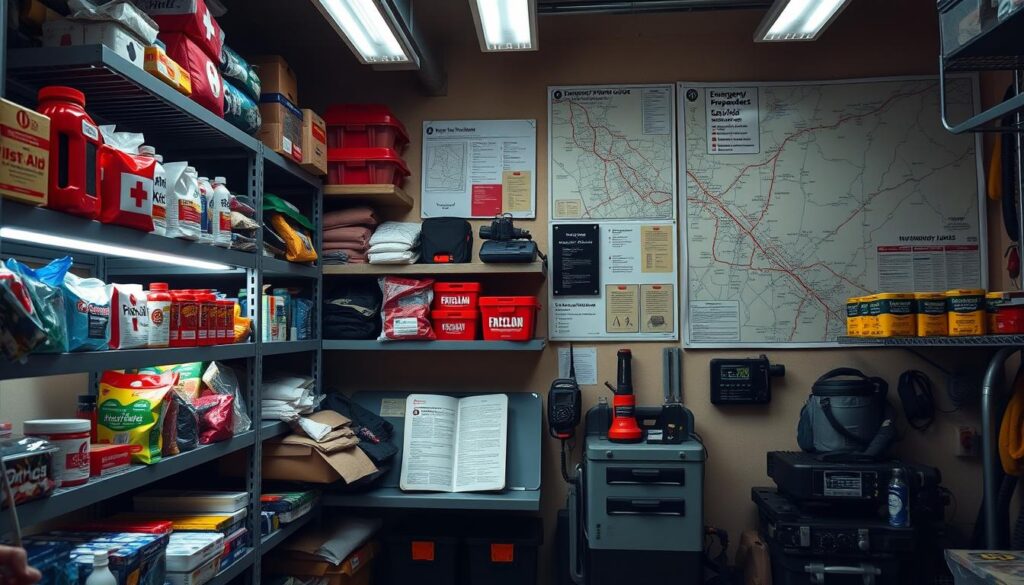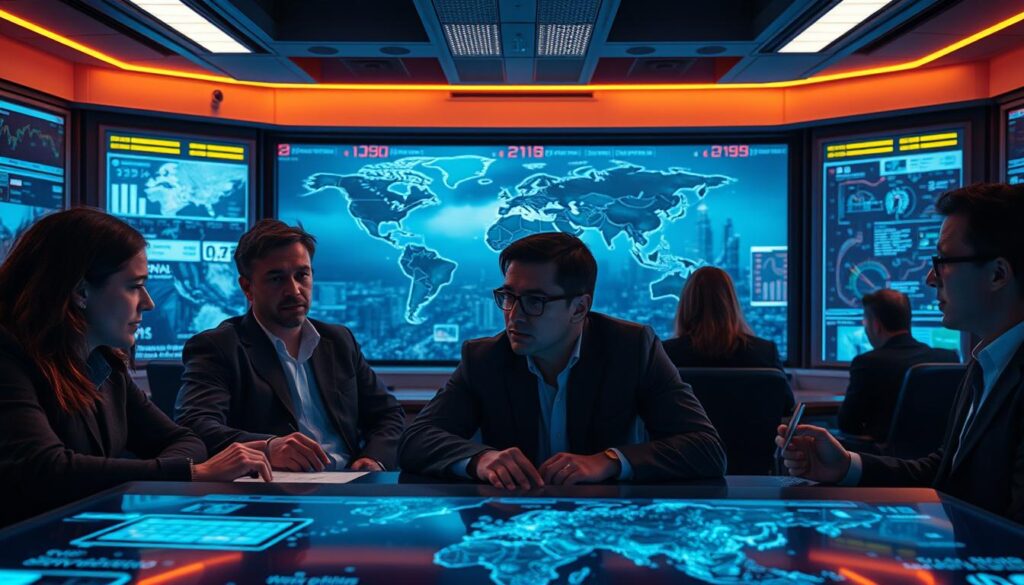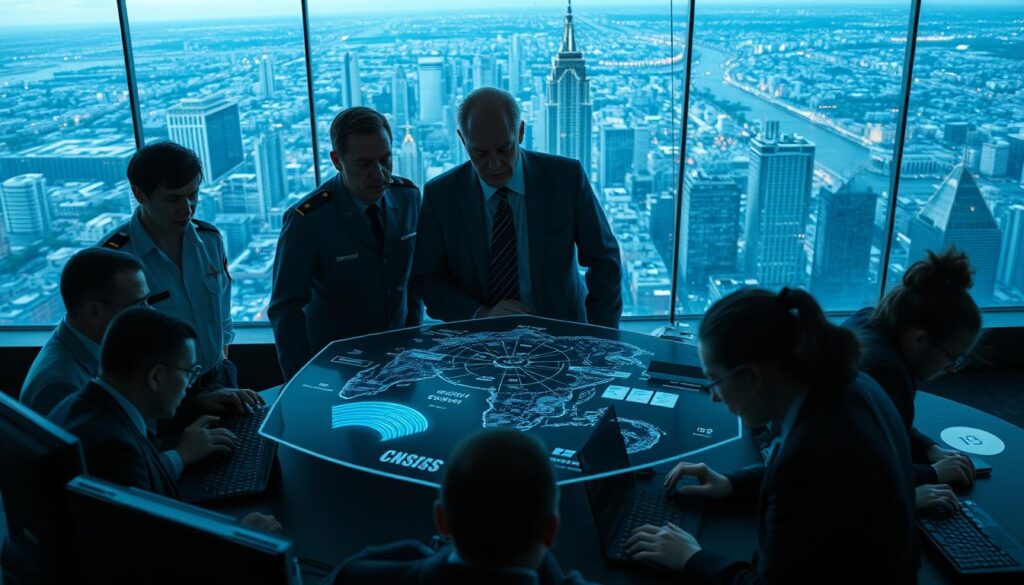Thinking back on my crisis management experiences, I remember Dr. Jeffrey C. Fox’s words. He compares great crisis leaders to lighthouses. They offer direction, hope, and safety in tough times.
Effective crisis management is key in emergencies. It needs skills like communication, decision-making, and team management. I’ve learned that emergency response is more than just reacting. It’s about leading with vision and staying strong.
This guide aims to cover the vital skills and strategies for leading in emergencies. It offers insights on how to lead well when faced with challenges.
Key Takeaways
- Understanding the importance of effective crisis management
- Developing key skills for emergency response
- Strategies for leading teams during crises
- The role of communication in leadership during emergencies
- Building resilience in the face of adversity
Understanding Leadership in Emergencies
Leadership in emergency situations is complex and vital. It requires specific skills and traits to manage crises well.
The Importance of Decisive Action
In emergencies, decisive action is key. Leaders must make quick, informed decisions, even with little information. They use skills like communication and problem-solving to guide others (Leadership in Emergencies Toolkit). Quick action can lessen the emergency’s impact.
Decisive action comes from experience, knowledge, and staying calm. Good leaders quickly assess situations, make informed decisions, and communicate well with their teams.
- Assessing situations rapidly
- Making informed decisions
- Communicating clearly with their teams
Characteristics of an Effective Emergency Leader
Effective emergency leaders have unique traits. These traits help them handle complex crises. Some key characteristics include:
- Strong Communication Skills: Clear and concise communication is vital.
- Problem-Solving Abilities: Leaders must analyze and solve problems effectively.
- Interpersonal Skills: Trust and rapport with team members are essential.

By developing these traits, people can improve their leadership skills in emergencies. Using crisis leadership techniques also boosts their emergency management abilities.
Emergency preparedness goes beyond having plans. It also involves developing leadership skills to execute those plans effectively.
Preparing for Emergencies
Getting ready for emergencies needs a plan that covers many bases. This includes making a plan, training, and having a network of support. As a leader, it’s important to have a solid strategy. This is key for managing crises well and showing strong strategic leadership.
Developing a Complete Emergency Plan
A detailed emergency plan is the core of any emergency preparedness effort. It lays out the steps to take during a crisis, ensuring a quick and organized response. Studies by Reynolds & Knox (2019) show that practicing disaster management boosts disaster plans a lot.
The plan must include risk checks, how to use resources, and how to communicate. It’s also vital to know who the key people are and what they do in an emergency.
| Component | Description | Importance Level |
|---|---|---|
| Risk Assessment | Identifying possible risks and weaknesses | High |
| Resource Allocation | Deciding how to use resources for emergencies | High |
| Communication Strategy | Setting up clear ways to communicate | High |
Training and Drills: Why They Matter
Training and drills are key parts of crisis management. They make sure people know how to act in emergencies. Regular training and drills show where to improve and make the team better at responding.
“Training is not just about following procedures; it’s about understanding the reasoning behind them and being able to adapt in high-pressure situations.”
Building a Support Network
A support network is essential for getting the help needed in emergencies. This network can include teams inside the organization, outside partners, and community resources. Keeping these relationships strong is important for good emergency preparedness.

In summary, getting ready for emergencies means planning well, training often, and having a strong support network. By focusing on these, leaders can make their teams better at handling crises.
Communication Strategies in Crisis Situations
The ability to communicate well is key for leaders in crises. Good communication helps reduce risks, keeps everyone safe, and boosts team morale.
Clear and Concise Messaging
In emergencies, clear and simple messages are essential. Leaders should speak directly and avoid confusion. Being open and honest helps keep rumors down and keeps morale up (Jones, Thompson, Schetter, Silver, 2017).
Key elements of clear and concise messaging include:
- Direct and simple language
- Avoiding jargon and technical terms unless necessary
- Repeating critical information to ensure understanding
Utilizing Technology for Better Communication
Technology is a big help in crisis communication. Leaders can use tools like:
- Emergency alert systems
- Collaboration software
- Social media for external communication
Regular updates and town hall meetings keep everyone informed and transparent.

| Communication Strategy | Benefits | Challenges |
|---|---|---|
| Clear and Concise Messaging | Reduces confusion, ensures understanding | Requires simplicity, may oversimplify complex issues |
| Utilizing Technology | Enhances reach, facilitates real-time updates | Dependent on technology infrastructure, may have security risks |
Building Trust and Credibility
In times of crisis, leaders who build and maintain trust stand out. Being visible, calm, and organized helps reduce staff anxiety. It also makes team members feel secure (Bluth, Kay, Smetherman, DeVun, Eick, Matthews, Sullican, 2007).
Establishing Authority in Uncertain Times
To be a leader, you must show strategic leadership by making smart decisions and clear communication. This means:
- Being open about the situation and your plans
- Believing in your team’s ability to handle the crisis
- Staying calm, even when things get tough
This way, leaders can boost their team’s confidence and lead them through tough times.
Being Transparent and Honest
Being open and honest is key to building trust. Leaders should:
- Share the challenges and how you’re tackling them
- Admit when you don’t know everything, showing you’re willing to learn
- Keep your team informed about progress and any changes
By following these steps, leaders can create a culture of trust and teamwork. This is vital for leadership skills in emergencies.
Making Quick Decisions Under Pressure
Being able to make fast decisions in emergencies is key for leaders. They must handle complex situations and make quick, smart choices.
Good decision-making in crisis needs experience, instinct, and certain methods. One method is quick problem-solving. It helps leaders spot problems, find solutions, and act fast.
Techniques for Rapid Problem Solving
Quick problem-solving has a few steps:
- Defining the problem clearly
- Assessing the situation and gathering relevant information
- Identifying possible solutions and checking if they work
- Picking the best option and putting it into action
Incident commanders are key in this process. They create and carry out the plan and manage resources (Phillips, 1999). This method helps leaders make smart choices under stress.
Balancing Risks and Benefits
Another important part of emergency decision-making is balancing risks and benefits. Leaders must think about the risks and benefits of their choices. They need to consider both immediate and future effects.
| Decision Factor | Risks | Benefits |
|---|---|---|
| Rapid Evacuation | Potential for panic, resource strain | Saving lives, reducing injuries |
| Resource Allocation | Potential for misallocation, resource depletion | Efficient use of resources, effective response |
By using this framework, leaders can make better choices. These choices balance risks and benefits, improving their crisis management skills.
In summary, quick decision-making is a critical leadership skill. It can be improved with practice, training, and using structured decision-making methods.
Mobilizing and Motivating Teams
Mobilizing and motivating teams is key in crisis leadership. As a leader, inspiring and guiding your team well can greatly impact your organization’s emergency response.
It’s important to know how your team works during crises. Team members might feel stressed, anxious, or unsure, affecting their work and mood. Fawcett (2020) says leaders should care about team members’ personal needs and keep morale up through clear communication.
Understanding Team Dynamics in Crises
Team dynamics are essential in emergency responses. Communication, trust, and clear roles are key to team success. Leaders should:
- Set clear roles and responsibilities
- Encourage open and honest communication
- Build trust among team members
Knowing these dynamics helps leaders prevent problems and keep their team united and effective.
Techniques to Inspire Action
To inspire your team, you need leadership skills and crisis techniques. Some good methods include:
- Leading by Example: Show the behavior and work ethic you want from your team.
- Recognizing and Rewarding Efforts: Thank team members for their hard work and contributions.
- Providing Clear Guidance: Make sure team members know their roles and goals.
Using these methods, leaders can motivate their teams to do their best, even when things are tough.
Good leadership in emergencies is more than just giving orders. It’s about inspiring and motivating your team towards a shared goal. By understanding team dynamics and using the right techniques, leaders can boost their team’s crisis resilience and response.
Managing Resources Effectively
Managing resources well is key to handling emergencies. As a leader, it’s important to know that managing resources is more than just giving them out. It’s about strategic planning and prioritization.
During emergencies, resources are often scarce. So, it’s vital to use them wisely. This means looking at the situation, figuring out what’s most urgent, and then giving out resources for those needs. For example, in a crisis, medical supplies and staff might be the first priority. Ideal leadership in emergencies means making hard choices about how to use resources.
Prioritizing Limited Resources
Deciding what to do with limited resources needs a good understanding of the emergency and what’s available. Leaders must figure out the crisis, find out what’s most urgent, and then give out resources for those needs. This might mean moving resources from less urgent areas or getting more from outside.
Good prioritization also means telling the team and others about the plan for resources. This helps manage expectations and makes sure everyone is working towards the same goals. For more tips on making a personal preparedness plan, check out crafting a personalized preparedness plan.
Budgeting for Emergency Situations
Having a budget for emergencies is key to crisis management and emergency preparedness. Leaders need to make sure there’s enough money to handle emergencies well. This means setting aside a budget for emergencies and checking it often to make sure it’s enough.
A good emergency budget lets organizations respond fast and well, lessening the crisis’s impact. It also helps use resources wisely, cutting down on waste and getting better results.
In summary, managing resources well in emergencies needs strategic leadership, smart prioritization, and budgeting. By understanding the importance of resource management and using these strategies, leaders can handle crises better.
Evaluating and Learning from Past Emergencies
Looking back at past emergencies helps us get better at leading in crises. We can spot what needs work and plan smarter for the next time. This way, we can lead more effectively in future emergencies.
Conducting After-Action Reviews
After-action reviews are key to learning from past emergencies. We check how we did, see what went right, and figure out what we can do better. Dr. Jeffrey C. Fox said these reviews help us do better next time or avoid problems altogether.
These reviews follow a few important steps:
- Identifying the key objectives and outcomes of the emergency response
- Assessing the effectiveness of our response strategies
- Determining the root causes of any issues or challenges that arose during the response
- Developing recommendations for improving future responses
Incorporating Lessons Learned into Future Plans
Using what we learned from past emergencies is vital for better crisis management. We update our emergency plans and training to use these insights. This way, we’re ready for future emergencies and can lead more effectively.
To make sure we use these lessons well, we should:
- Update our emergency plans to reflect the insights gained from our after-action reviews
- Modify our procedures to address any identified areas for improvement
- Revise our training programs to ensure that our teams are equipped to respond effectively to future emergencies
Staying Resilient as a Leader
Being a leader means staying strong during tough times. It’s key to manage crises well. Leaders must handle challenges while keeping their skills sharp.
Prioritizing Self-Care
Self-care is vital for leaders facing crisis demands. Eating right, exercising, and caring for mental health are musts. Studies show sleep and mental health are key to resilience (Slepski, Couig, Lavin, Orsega, Goodwin-Veenema, 2019).
Building Personal Resilience
Personal resilience helps leaders face tough times. By learning crisis management and focusing on well-being, leaders can handle emergency stresses better.
By focusing on self-care and building resilience, leaders can boost their skills. This makes them better at leading during crises.
FAQ
What are the essential skills required for effective leadership in emergencies?
To lead well in emergencies, you need good communication, decision-making, and team management skills. Leaders must influence others, make quick decisions, and manage resources well.
How can I prepare my organization for emergencies?
To get ready for emergencies, create a detailed emergency plan. Also, do training and drills, and build a support network. This helps find areas to improve and ensures you have the right resources.
What role does communication play in crisis situations?
Communication is key in crises. Leaders should send clear messages, use technology to talk better, and keep everyone updated. This builds trust and keeps everyone informed.
How can I build trust and credibility with my team during emergencies?
To gain trust, be open and honest, stay calm, and be seen by your team. This creates a sense of safety and stability when things are uncertain.
What techniques can I use to make quick decisions under pressure?
To make fast decisions, use quick problem-solving and weigh risks and benefits. Incident commanders are key in this, making and acting on plans.
How can I mobilize and motivate my team during emergencies?
Know your team and use methods to get them moving. Be aware of their needs and keep them updated. This boosts morale and motivation.
What strategies can I use to manage resources effectively during emergencies?
To manage resources well, prioritize them, use them wisely, and plan for emergencies. This ensures you have enough to handle the crisis.
How can I evaluate and learn from past emergencies?
Review past emergencies to find ways to improve. Use these lessons to make future plans better. This boosts preparedness and response.
What self-care strategies can I use to stay resilient as a leader during emergencies?
Take care of yourself by eating well, exercising, and focusing on mental health. Building personal resilience helps you handle tough times.
Why is crisis management important in emergency response?
Crisis management is key for effective emergency response. It helps leaders handle crises well, reduce damage, and speed up recovery.
How can I develop strategic leadership skills for emergency response?
Improve your leadership by learning leadership principles, practicing decision-making, and learning from past experiences. Stay updated with the latest crisis leadership techniques.



